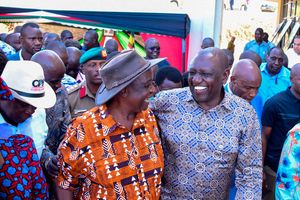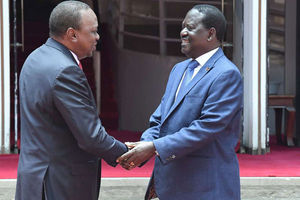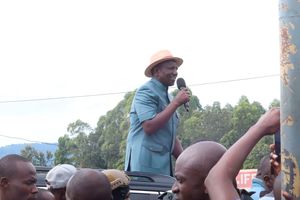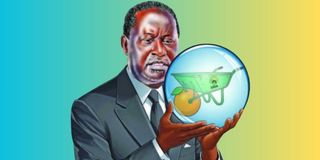
Analysts say the schism within Mr Odinga’s camp reflects a fundamental tension between political survival and ideological purity in the broad-based government arrangement with President William Ruto.
As a deepening crisis of public divisions tears at the heart of Raila Odinga’s famed political juggernaut, the risk of Kenya’s most storied opposition party imploding and leaving the veteran politician with depressed support ahead of 2027 is no longer a far-removed reality.
Analysts say the schism within Mr Odinga’s camp reflects a fundamental tension between political survival and ideological purity in the broad-based government arrangement with President William Ruto.
On one side are the accommodationists; ministers, governors and legislators, who benefited from the Ruto administration patronage or promise of better days ahead. They argue that continued cooperation offers them a micro-opportunity to demonstrate how an ODM government would function. On the other hand are loyalists, who see an alliance with the ruling United Democratic Alliance (UDA) as an existential threat to Mr Odinga’s standing and the future of the party.
The current conflict, unlike past internal disputes, unfolds openly—in press conferences, social media spats, and competing public declarations—with two factions advancing opposite visions for ODM’s future. The opposing camps openly pitched their positions at the funeral of fallen Kasipul MP Charles Ong’ondo Were last week, prompting Mr Odinga to caution party secretary-general Edwin Sifuna to temper his “sting.”
The situation is even more dire, as Mr Odinga's inner circle is split into two opposing camps — both pledging allegiance to him. The crux of the matter is whether their leader should continue his broad-based government dalliance with President Ruto or break off and prepare to run against him in 2027.
The veteran leaders’ renowned political reinvention skills will face a test as he considers another presidential run. Within his own ODM party, significant concerns are being raised.
These include the risk that his support base, now familiar with the advantages of being in government, may be unwilling to return to the opposition. Additional challenges involve potential infiltration by the ruling UDA party, among other factors that are giving his strategists cause for concern.
The fear of contamination is real, as pointed out by the ODM chairperson and Homa Bay Governor Gladys Wanga.
“As the national chairperson of ODM, I want to make it very clear that Homa Bay County and the entire Nyanza region are ODM zones. The next time I see people shouting 'UDA', we will not agree; we will not accept it. It will not happen under my watch as national chairperson of the ODM party," she says.
In his timeless novel A Man of the People, celebrated Nigerian author Chinua Achebe provides insight into the psychology of opposition figures who join the government after years in the political wilderness.
His observations remain strikingly relevant to Kenya's contemporary political landscape; despite being set in post-independence Nigeria where a small elite replaced colonial powers as the new oppressors.
"A man who has just got back from the rain, dried his body, and put on dry clothes is more reluctant to go out again than one who has been indoors the whole time," Achebe writes, elegantly capturing the reluctance to return to opposition after tasting power.
Achebe further notes, "We ignore man's basic nature if we say, as some critics do, that because a man like Nanga has risen overnight from poverty and insignificance to his present opulence he could be persuaded without much trouble to give it up again and return to his original state."
This penetrating observation underscores the profound challenge of convincing those who have experienced power's comforts to willingly relinquish them.
A lingering concern is that Mr Odinga may order the troops back to the trenches and end up with only a few of them, as many of them may choose to stick with Ruto’s brigade, especially as key members of the party are already in contact with the Executive arm of government.
Those who advocate continued cooperation have either secured lucrative government positions, experienced the benefits of its generosity, or had projects fast-tracked in their regions, and would prefer to maintain this.
“Such manoeuvres are fraught with the risk of splitting parties in two, especially when the party is not fielding a presidential candidate. What do you do when some members defy the leader to remain in the current arrangement?” Prof Godwin Siundu asked.
Analysts argue that a sixth attempt would endanger Mr Odinga’s health by subjecting him to the rigours of presidential campaigns at the age of 82. Mr Odinga run for top office in the 1997, 2007, 2013, 2017 and 2022 presidential elections.
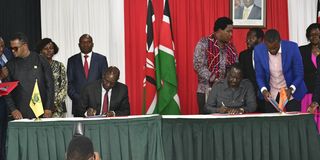
President Willam Ruto and ODM party leader Raila Odinga during the signing of a Memorandum of Understanding between ODM and UDA at Kenyatta International Convention Center in Nairobi on March 07, 2025.
“What would be different this time, when the odds against us are starker than before?” They ask.
To emphasise their point, some quarters in ODM argue that if Dr Ruto, an outsider, defeated them in 2022 when they had the support of the incumbent president, Uhuru Kenyatta, and the State machinery, it would take a miracle to defeat him now.
Mr Odinga’s ODM party has at least five senior members sitting in Dr Ruto’s Cabinet. There are many other direct and indirect appointees.
The Cabinet secretaries are: Opiyo Wandayi (Energy), John Mbadi (National Treasury), Hassan Joho (Mining), Wycliffe Oparanya (Cooperatives) and Beatrice Askul (EAC).
Then there are ideologues such as ODM secretary-general Mr Sifuna and Siaya Governor James Orengo, who believe that any continued association with the UDA leader diminishes their brand. They argue that Mr Odinga should disengage immediately.
They warn of an “incumbency curse” in 2027, as they will be judged alongside President Ruto — exactly the position Mr Odinga found himself in during the last election.
Dr Ruto seized every opportunity to remind voters that Mr Odinga was part of the “repressive” Uhuru Kenyatta administration that made life difficult for them. That “he was the messiah who would save them from it”. Somehow, the message sank in. And he won the prize.
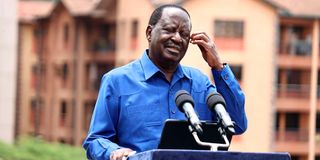
ODM leader Raila Odinga addressing the press in Nairobi on November 15,2024.
Unlike the 2018 “handshake” with the then President Kenyatta, Dr Ruto will be seeking to extend his tenure as the country's chief executive after the 2027 elections.
Should Mr Odinga choose to run, as his brother Oburu Oginga suggests he should, he will go from being Dr Ruto's “handshake” brother to being his competitor for the second time in five years.
“As it stands, there is no deal with Dr Ruto for the 2027 General Election. If Kenya Kwanza Alliance fulfil their promises as stated in the MoU, we will continue working together; otherwise, we will part ways if we feel they have not met their end of the bargain before the next elections," said Dr Oginga.
Not running would expose politicians who have always won their seats by telling their supporters that “Raila needs them in Nairobi as part of his ammunition to advance the national agenda”.
Sunday Nation understands that the vast majority of those who want Mr Odinga to run come from this camp. They know that his absence from the ballot would open up the race for local seats, something they cannot reconcile themselves with.
If the former Prime Minister were to choose that route, it wouldn’t be the first time that he has disengaged from such an arrangement in order to run for office.
After leading his NDP party into a merger with President Daniel Moi’s Kanu in 2002, Mr Odinga left the alliance when he found out that Moi intended to support Mr Kenyatta in the presidential election later that year. He later teamed up with other opposition leaders to block Mr Kenyatta's path to State House, supporting Mwai Kibaki who went on to win by a large margin.
“I am a life member of ODM and I am not about to relinquish that. I am the longest-serving chairman of ODM. I am putting a lot of effort into reforming the economy because I want to demonstrate to the whole country that these are the people Raila would have gone into government with, and this is what they would have done. If I am there, I expect 100 per cent loyalty from the party, starting with the Secretary General,” said Treasury CS Mr Mbadi.
Should he decide to return his troops to the opposition benches, Mr Odinga will have to contend with a trust deficit and cynicism from the likes of Wiper leader Kalonzo Musyoka, who accuse him of opening a back channel with Dr Ruto immediately after the 2022 elections without involving them, even though they were all principals of the Azimio coalition.
Mr Odinga faces the same accusations regarding the 2018 “handshake” with Mr Kenyatta, again keeping his National Super Alliance counterparts in the dark.
Former Deputy President Rigathi Gachagua has publicly offered to join forces with Mr Odinga in their bid to make Dr Ruto a one-term President. He even went so far as to suggest that they would back Mr Odinga for the top seat.
“Welcome back home, our son Raila Odinga, with your head held high; East or West, home is the best. In any case, the outcome at the AU doesn't, in any way, undermine your leadership and your energy to fix our Nation. We will make whatever sacrifices necessary to make sure William Ruto is a one-term President,” Mr Gachagua said immediately Odinga lost the bid for African Union Commission chairmanship on February 15.
There are also concerns that bolting out in the run-up to the polls would give him little or no time to put his house in order, while the other two camps are already campaigning.
Finally, those against his bid cite age to buttress their point. He is 80 now. Meaning he’d be 82 in 2027 and may struggle coping up with youthful candidates in the campaign trail, they say.


